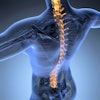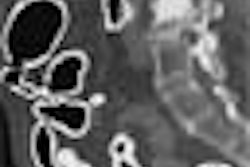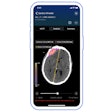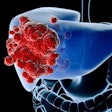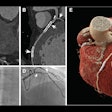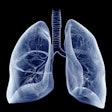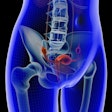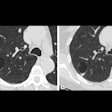BOSTON - The ads are not subtle as they blare their enthusiastic message from Web sites, newspapers, and the broadcast media. "Your health is priceless! Why take a chance?" Why gamble indeed, when one can find peace of mind in a visit to one of the hundreds of CT screening centers spreading across the U.S. like Wal-Marts.
One site urges readers to join "the search for major killer diseases like stroke, aneurysms, cancer, and lymphoma." Screening seems almost fun, and it's definitely not just for cancer anymore. "Our body scan," the ad says, "can also detect non-life-threatening problems such as gallstones, arthritis, kidney stones, and osteoporosis." One center ran a Mother's Day special for whole-body screening, encouraging family members to "Give the gift of life!"
Dr. Lincoln Berland, who runs a screening center of his own at the University of Alabama in Birmingham, questions the blitzkrieg approach to preventive diagnostics. In a talk on Sunday at the Society of Computed Body Tomography and Magnetic Resonance’s "Medically Principled CT Screening" course, he proposed another way to build a CT screening center.
"The underlying implication with these kinds of statements is, well, if we find these things that are so terrible, why can't we cure them?" he said. Occult disease certainly can be found and cured in asymptomatic patients, but not as consistently as the advertisements seem to imply.
For some radiologists, then, the question becomes how to establish a screening center in ways that are ethical, and contribute to the health and well-being of patients. First, Berland said, make sure you really want to do it. If you really do, proceed cautiously and ethically.
Screening centers are popular with providers because they represent a practice opportunity. Reimbursement is 100%, and doctors get their cash up-front.
"It's an entry point into your health system," Berland said. "I don't think we should underestimate the motivation that screening centers have for doing screening. It's not to get the revenue from the screening, it's to capture people into their health system."
A screening service can be difficult to establish and maintain properly. Mammography should be the model for screening, since it has rigorous requirements for communicating with patients, writing follow-up letters, and providing adequate referrals, Berland said. Some screening sites counsel patients before they leave the premises.
Another pitfall is the heavy workload, particularly when the center is in the startup phase.
"You're going to be getting the very worried well, not just the worried well," he said. "These people are very anxious, and very time-consuming. The first people who called us before we even announced the screening program drove some of us up the wall with their anxiety about what we're offering, and what they need to do. This time needs to be factored into your cost issues."
There can be opposition from physicians, too, he said, particularly from specialists such as cardiologists who might see the center as competition. Primary-care physicians aren't only afraid of losing their patients, they understand they will be faced with lots of incidental findings they'll need to follow up on, and they may be unsure how to proceed.
Two basic models can be followed: the dedicated screening center and the integrated model with diagnostic services.
Dedicated screening centers
These are frequently established by corporate chains, with marketing costs that can exceed $50,000 a month. Many of them, particularly those that perform electron beam CT coronary screening, are established by cardiologists, who may hire radiologists to interpret the scans, while the cardiologists are relegated to recording the patient's total calcium score, Berland said.
Dedicated screening centers tend to focus on better service and amenities, with some creating spa-like environments offering patients refreshments, thick terry-cloth robes, and free parking.
Integrated model
Integrated centers are healthcare facilities that also offer screening. Screening services can certainly be promoted, but there is usually less incentive to do so than in the dedicated center, which is financially dependent on screening, Berland said.
Problems can arise when well individuals undergoing screening are put together with sick patients, who for their part don't always appreciate the screening clients' extra perquisites such as free parking, Berland said.
Integrated centers also face additional regulatory issues involving Medicare. For example, a screening center may not be able to bill a Medicare patient directly for screening, even when Medicare doesn't cover the screening exam. The radiologist would have to bill Medicare first to try to recoup the fee before passing the bill on to the patient.
Screening establishments perform services ranging from coronary artery calcium scoring (CACS) to lung cancer, virtual colonoscopy, whole-body CT, abdominal aortic aneurysm (AAA) evaluation, renal and liver cancer screening, and bone mineralization assessment.
"Whole-body (screening) is probably not an appropriate application because the kinds of things you're looking for may not benefit the patient, and may cause more harm than good," Berland said.
As for AAA, there is some literature suggesting that screening for AAA can reduce mortality by 30% to 50%, he said. But these studies have been done with ultrasound.
"So if you're really going to be screening for AAA -- and this is a whole issue that could be debated separately -- you shouldn't be using CT," Berland said. Ultrasound would be much cheaper, and nearly as effective as CT.
Renal cancer is rare, and most types have a low mortality rate, while incidental liver lesions in patients without a primary malignancy are almost always benign, he said.
Cost issues
To manage costs, Berland's center relies on soft-copy reading exclusively, no film, and voice-recognition reporting, which eliminates the need for transcriptionists.
"Revenue per case ... strongly depends on throughput," Berland said. "If you're going to have fixed costs that relate to buying software to do the kinds of things you need to do, then how many cases you get through is going to make a big difference." It is probably the single most important factor affecting the profitability of performing these types of examinations, he added.
There is no third-party coverage for screening, and the center may incur additional costs in at least one state, New York, which has recently prohibited such payments when they relate to the follow-up of incidental findings in screening exams.
Charges for screening services have been dropping in very competitive markets, Berland said. Screening revenues are secondary to academic opportunities in Berland's group, which charges $395 for a heart scan and $650 for virtual colonoscopy. The center also performs lung scans as part of the National Lung Screening Trial.
Radiologists' time with patients costs money, so the amount of time spent together must be controlled. The physicians also need to be careful of the kinds of statements they make to patients, according to Berland.
Legally, it has been established that the screener may become the de-facto primary-care physician for the individual being screened. The doctor is effectively taking on a new patient, and may be responsible for making sure the patient gets the right follow-up exam, and the right referral.
"Let's say a patient comes in for a lung scan referred by their gynecologist, and you just send a report of the positive lung nodule finding to the gynecologist," he said. "Well perhaps that's not appropriate referral, it's not satisfactory management of the patient, and you could be held liable for not appropriately referring the patient."
Principles
The patient should understand both the risks and benefits of screening, Berland said. His group includes statements of principles on the group's Web site, requires written consent for participation, and asks patients to complete an extensive questionnaire for each type of exam.
Still, signing a form doesn't hinder a patient's right to sue, as that would affect the patient's right to due process in the event of harm. Consent is nevertheless valuable for educational purposes, since patients may be more likely to read something they have to sign, he said.
"We pepper our consent form with numerous statements of how (screening) may not be a good idea," Berland said. "We want them to know that this is not an all-positive situation, that they may end up having further exams and getting injured."
There is a tradeoff of quality versus time at Berland's center, in that patients download and complete the form on their own, rather than having it presented in person.
However, only trained, scripted callers are allowed to communicate with the patient when scheduling the exam. They do not answer substantive questions, which are passed on to a technologist, and if necessary to Berland or another radiologist in the program.
Patients must have a doctor to review the results, and the group is moving toward physician referral for most patients. When testing is complete, the patients receive a report in plain English by mail. The center retains the records and recommendations, and follows up on the patients, he said.
Exclusion criteria are followed to ensure that screening patients are at risk of disease. For colon screening, patients must be 50 years of age or have a family history of colorectal cancer; for lung screening they must generally be current or former smokers with at least 10 pack years (i.e., having smoked the equivalent of a pack of cigarettes a day for 10 years), Berland said.
It's important to follow standards of practice rigorously, using radiologists who have extensive experience reading chest CTs, for example, or significant experience in performing virtual colonoscopy, he said.
Berland and colleagues communicate the results to the patient and referring physician by letter, and in the case of potentially serious findings, by a phone call to the patient, which is documented as an addendum to the report.
The screening practice should be based on medical principles, using medically appropriate screening indications, Berland concluded. Promotion and advertising should be worded conservatively.
By Eric BarnesAuntMinnie.com staff writer
November 12, 2002
More information about the University of Alabama's screening center is available at www.health.uab.edu, and at www.rad.uab.edu. A CD-ROM of the entire SBCT/MR course is available at the organization's Web site.
Related Reading
Whole-body CT: Radiology to the people?, October 2, 2002
Following up incidental findings may do more harm than good, September 5, 2002
CT, x-ray to face off in lung cancer screening megatrial, September 19, 2002
Half-dose chest CT produces acceptable image quality, August 5, 2002
Copyright © 2002 AuntMinnie.com



